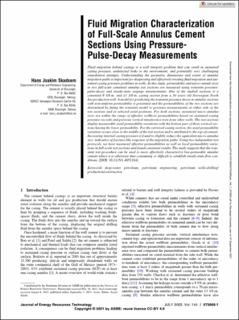| dc.contributor.author | Skadsem, Hans Joakim | |
| dc.date.accessioned | 2021-09-24T07:03:37Z | |
| dc.date.available | 2021-09-24T07:03:37Z | |
| dc.date.created | 2021-08-17T11:33:29Z | |
| dc.date.issued | 2021 | |
| dc.identifier.citation | Journal of energy resources technology. 2021, 144 (7), 073005-01-073005-13. | en_US |
| dc.identifier.issn | 0195-0738 | |
| dc.identifier.uri | https://hdl.handle.net/11250/2781272 | |
| dc.description.abstract | Fluid migration behind casings is a well integrity problem that can result in sustained casing pressure, undetected leaks to the environment, and potentially very challenging remediation attempts. Understanding the geometric dimensions and extent of annular migration paths is important for diagnosing and effectively treating fluid migration and sustained casing pressure problems in wells. In this study, permeability and micro-annuli sizes in two full-scale cemented annulus test sections are measured using transient pressure-pulse-decay and steady-state seepage measurements. One of the studied sections is a cemented 9 5/8-in. and 13 3/8-in. casing section from a 30 years old Norwegian North Sea production well. A model for predicting the transient pressure decay in annular sections with non-uniform permeability is presented and the permeabilities of the two sections are determined by fitting the transient model to pressure measurements at either side of the test sections and at selected axial positions. For both sections, measured micro-annulus sizes are within the range of effective wellbore permeabilities based on sustained casing pressure records and previous vertical interference tests from other wells. The test sections display measurable axial permeability variations with the bottom part of these vertical sections having the lower permeability. For the retrieved casing section, the axial permeability variation occurs close to the middle of the test section and is attributed to the top-of-cement. Increasing internal casing pressure is found to slightly reduce the equivalent micro-annulus size, indicative of fracture-like response of the migration paths. Using two independent test protocols, we have measured effective permeabilities as well as local permeability variations in full-scale test sections and found consistent results. The study suggests that the transient test procedure can be used to more effectively characterize low-permeable annular cement where it is otherwise time-consuming or difficult to establish steady-state flow conditions. | en_US |
| dc.language.iso | eng | en_US |
| dc.rights | Navngivelse 4.0 Internasjonal | * |
| dc.rights.uri | http://creativecommons.org/licenses/by/4.0/deed.no | * |
| dc.title | Fluid Migration Characterization of Full-scale Annulus Cement Sections Using Pressure-Pulse-Decay Measurements | en_US |
| dc.type | Peer reviewed | en_US |
| dc.type | Journal article | en_US |
| dc.rights.holder | Copyright © 2021 by ASME | |
| dc.description.version | publishedVersion | en_US |
| cristin.ispublished | true | |
| cristin.fulltext | original | |
| cristin.qualitycode | 1 | |
| dc.identifier.doi | 10.1115/1.4052184 | |
| dc.identifier.cristin | 1926584 | |
| dc.source.journal | Journal of energy resources technology | en_US |
| dc.source.volume | 144 | en_US |
| dc.source.issue | 7 | en_US |
| dc.source.pagenumber | 073005-01-073005-13 | en_US |
| dc.relation.project | Norges forskningsråd: 308767 | en_US |

